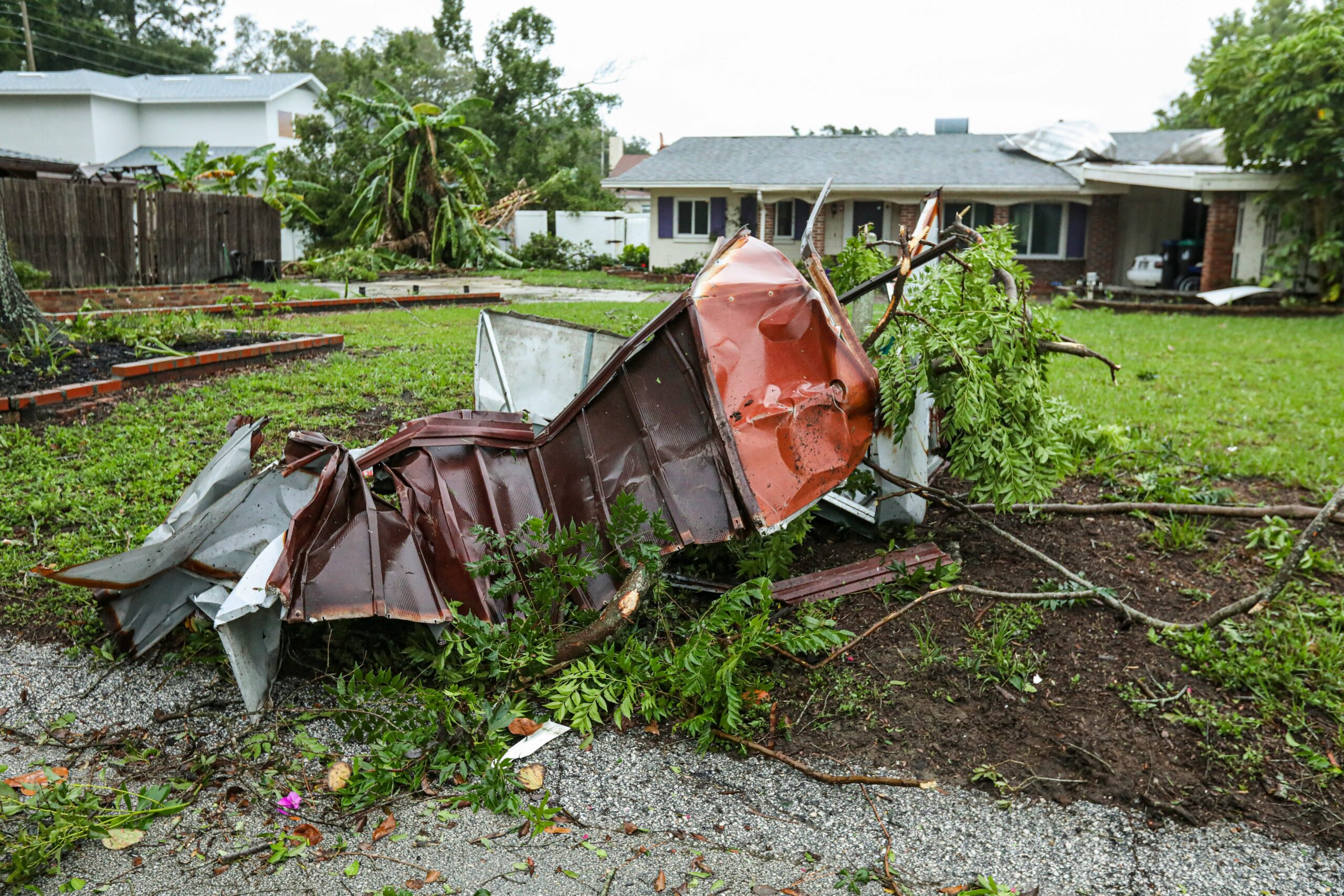Introduction to Storm Éowyn
Storm Éowyn is a notable meteorological event that has captured attention due to its significant implications for the weather patterns in Scotland and surrounding regions. Originating from a complex interplay of atmospheric conditions, Storm Éowyn emerged in late 2023 and was named in accordance with the UK Met Office’s naming conventions, which aim to enhance public knowledge and awareness of severe weather events. The naming practice also aids in improving communication regarding the impacts and preparedness efforts associated with such storms.
Storms are categorized based on their intensity, potential impacts, and the conditions that give rise to them. In this context, Storm Éowyn has been categorized as a strong weather disturbance, marked by high winds and heavy precipitation, which are anticipated to have profound effects. The storm’s trajectory and strength have been subjects of continuous assessment by meteorological agencies, ensuring that accurate forecasts are made available to the public. These forecasts are essential for informing residents and local authorities about the potential hazards associated with the storm.
In Scotland, the expected impacts of Storm Éowyn are particularly concerning, as the region is accustomed to harsh weather but this storm presents unique challenges. Local communities may face disruptions due to high winds, flooding, and potential transportation issues. Consequently, advance warnings have been issued to prepare individuals and businesses. The need for readiness emphasizes the significance of storms like Éowyn within the broader context of climate change and increasing weather variability. By understanding the origins and implications of Storm Éowyn, individuals and local governments can better navigate the challenges posed by such intense weather events.
Met Office Weather Warnings Explained
The Met Office plays a crucial role in safeguarding public safety during adverse weather conditions through its weather warning system. These warnings are categorized into distinct levels, each serving a specific purpose and conveying vital information regarding potential weather hazards. The system consists of three primary categories: Yellow, Amber, and Red, each indicating varying levels of severity and impact.
A Yellow warning signifies that while the weather is likely to be disruptive, the situation is manageable with minimal precautions. It informs the public to remain vigilant and consider potential disruptions such as travel delays or minor property damage. Amber warnings, however, indicate that more severe weather is expected and may pose a risk to life and property. The public is advised to prepare for possible disruption and to exercise caution. Lastly, a Red warning signifies extreme conditions. It indicates that there is a danger to life and widespread damage is likely. In this case, individuals are urged to take immediate action to protect themselves, their families, and property.
The criteria for issuing these alerts are based on weather patterns, intensity, and predicted duration of the adverse conditions. For example, heavy rain, strong winds, or severe ice can trigger specific warnings. Meteorologists assess atmospheric data and models to determine the likelihood of significant impacts on daily life, which informs the level of alert issued. This proactive approach aims to minimize harm and enable the public to take necessary actions ahead of severe weather events, particularly during incidents like Storm Éowyn. By understanding these warnings, individuals can better prepare for the challenges posed by severe weather, ensuring a safer environment for themselves and their communities.
Impact of Storm Éowyn on Scotland’s Regions
Storm Éowyn has had a significant impact on several regions across Scotland, with varying degrees of severity depending on geographic location and climatic conditions. Among the areas that have reported considerable effects is the Erskine Bridge, which connects the towns of Erskine and Old Kilpatrick. The region has been especially vulnerable to inclement weather, experiencing heavy downpours alongside strong winds, which pose risks for traffic disruption and possible flooding.
Further south, the coastal town of Troon is bracing for the impact of Storm Éowyn. As a seaside location, Troon faces the dual challenges of high winds and elevated sea surges, which can lead to coastal erosion and hazardous conditions along beaches. Local authorities have issued warnings for potential high tide flooding, urging residents and visitors to remain vigilant and avoid low-lying areas during the storm’s peak.
Other regions, such as Fife and the Borders, are also anticipating adverse weather conditions. In these areas, heavy rainfall is expected, raising concerns regarding swollen rivers and the potential for localized flooding. Emergency management teams are on standby, prepared to respond to any emergencies that may arise due to rapid inundation of roads and properties. The Scottish Environment Protection Agency (SEPA) has warned communities to prepare for possible road closures and evacuations should flood levels rise beyond predicted thresholds.
In summary, Storm Éowyn has the potential to exacerbate already challenging weather patterns across Scotland. The varied impacts on regions, such as Erskine Bridge and Troon, underscore the importance of monitoring weather advisories and government updates to ensure community safety. Citizens are encouraged to stay informed and prepare for the storm’s significant weather conditions in the coming days.
Travel Disruptions and Road Closures
Storm Éowyn has significantly affected travel across Scotland, prompting severe weather warnings and impacting numerous routes. Key arteries into and around major cities have experienced disruptions, notably the Kessock Bridge, which has been closed to traffic due to high winds and safety concerns. This closure has necessitated diversions, leading drivers to seek alternative routes, resulting in longer travel times and increased congestion in other areas. Travelers are urged to remain informed about current conditions to avoid unnecessary delays.
Public transport services have also felt the repercussions of this storm. Avanti West Coast, a prominent rail operator, has reported potential delays and cancellations as a result of adverse weather conditions. Passengers taking trains from Scotland to England may experience interruptions in service, and it is recommended that those planning to travel check the latest updates from the provider. Trains may run at reduced speeds to ensure safety, leading to extended journey times.
Motorists are advised to exercise caution when traveling during Storm Éowyn due to treacherous conditions, including reduced visibility and the risk of fallen branches or debris on the roads. Furthermore, the likelihood of localized flooding in certain areas may pose additional challenges for drivers. Road traffic authorities urge travelers to stay tuned to real-time updates regarding closures and diversions to better plan their journeys.
In light of these disruptions, it may be prudent for individuals to reconsider their travel plans. If travel is not essential, waiting for improved weather conditions could be advantageous. Nonetheless, those who must travel should adhere closely to travel advisories and stay informed about the changing situation across Scottish transport networks. Safety should always remain a priority during extreme weather events such as Storm Éowyn.
Power Outages and Infrastructure Challenges
Storm Éowyn has brought significant disruptions to the power supply across various regions in Scotland, leading to widespread outages and infrastructure challenges. Utility companies, particularly Scottish Power, have faced considerable obstacles in maintaining electrical reliability amid the storm’s fierce winds and heavy precipitation. These adverse weather conditions can cause tree branches to fall onto power lines, resulting in immediate power cuts that leave many households without electricity.
The impact of such outages can be profound, affecting not only residential customers but also critical services such as hospitals and emergency response centers. In the wake of Storm Éowyn, numerous reports indicated extensive power outages across several regions, highlighting the vulnerability of the electric grid to extreme weather events. Utility companies typically monitor weather forecasts and prepare for possible disruptions; however, the scale and severity of this storm exceeded many anticipations.
In response to the challenges posed by Storm Éowyn, utility service providers have activated their emergency plans, which include deploying additional repair crews and equipping them with the necessary tools to restore power effectively. Communications with affected communities remain a priority; Scottish Power has employed online platforms to keep customers informed about the status of outages and expected restoration times. This transparent approach is essential not only for managing customer expectations but also for building trust during crisis situations.
Moreover, these incidents underline the necessity for ongoing investment in infrastructure resilience. As the frequency and intensity of storms increase due to climate change, it is crucial for utility companies to continuously evaluate and upgrade their systems. This adaptation may include reinforcing power lines, implementing advanced monitoring technologies, and enhancing tree-trimming programs to mitigate future impacts. Such proactive measures are essential to ensure a reliable power supply as weather patterns continue to evolve.
Weather Patterns: The Sting Jet Phenomenon
The sting jet phenomenon is a significant meteorological event that can have profound implications for severe storm systems, including those impacting Scotland, such as Storm Éowyn. A sting jet refers to a narrow, fast-moving column of air that descends from the mid-level troposphere during certain atmospheric conditions, particularly in extratropical cyclones. These jets can produce intense and localized wind gusts that are often stronger than the associated storm’s overall winds, leading to hazardous conditions.
The development of a sting jet typically occurs within a well-defined structure of a mature cyclone. As the storm intensifies, warm air is lifted and cool air descends, creating a dynamic that can lead to the formation of these jets. The difference in temperature and pressure between various air masses encourages the acceleration of winds, ultimately resulting in a concentrated outflow that can descend rapidly towards the surface. When this phenomenon occurs, the consequences can be severe. For instance, wind speeds can reach upwards of 70 knots (approximately 80 mph), causing damage akin to straight-line winds associated with tornadoes.
During storms like Éowyn, sting jets can exacerbate the impacts of already prevalent weather conditions. They can lead to rapid changes in wind direction and intensity, contributing to blowing debris, uprooted trees, and widespread power outages. Furthermore, understanding the dynamics of sting jets is crucial for meteorologists, as their sudden nature poses challenges for forecasting. Accurate predictions can allow communities to prepare more effectively for the accompanying severe weather. Consequently, as Storm Éowyn and similar weather events develop, close attention to these sting jets becomes essential for assessing potential impacts across Scotland.
Public Safety Recommendations
During extreme weather events like Storm Éowyn, public safety becomes paramount. Individuals and families are advised to remain indoors to minimize exposure to the severe conditions that the storm may bring. It is essential to stay updated with the latest information, particularly through official channels such as the Met Office. Their alerts provide critical details about storm developments and recommended safety measures, ensuring that citizens are well-informed.
In preparation for potential power cuts, households should take proactive steps. Stock up on essential supplies such as bottled water, non-perishable food items, and battery-operated equipment like lanterns or radios. These preparations will provide necessary resources during outages that can last for an extended period. It is advisable to charge mobile devices in advance and have a backup power solution if available, such as portable chargers. Families should consider creating a basic emergency kit that includes first aid supplies, blankets, and a list of emergency contacts.
Additionally, safeguarding property from adverse weather is crucial. Secure outdoor furniture and decorations that may become projectiles in high winds. Check that gutters and drains are clear to prevent water damage and flooding. If possible, reinforce windows and doors to withstand heavy winds and rain, as this can mitigate potential damage to the property.
Ultimately, the prudent approach during Storm Éowyn involves following safety protocols and heeding the warnings issued by authorities. By adhering to these recommendations, residents can better protect themselves and their families from the potentially devastating impacts of this storm. Being prepared and informed can significantly reduce risks and enhance overall safety during these tumultuous weather conditions.
Community Response and Support Efforts
During Storm Éowyn, local communities and governmental agencies in Scotland demonstrated remarkable resilience and coordination in responding to the severe weather conditions. In anticipation of potential impacts, emergency services proactively implemented response plans to ensure public safety. The Scottish Government, along with local authorities, mobilized resources to address the immediate needs of those affected by the storm.
Emergency services, including police, fire, and ambulance teams, were on high alert, ready to assist residents in distress. They set up communication channels, ensuring that essential information regarding safety measures and road conditions was disseminated effectively. Dedicated hotlines were established, allowing citizens to report emergencies and receive timely guidance. Moreover, police forces urged individuals to stay indoors and avoid unnecessary travel, reinforcing the importance of safety during adverse weather.
In addition to governmental efforts, community support networks played a pivotal role in providing assistance to those impacted by Storm Éowyn. Local organizations collaborated to establish relief centers that offered shelter, food, and medical aid to individuals forced to evacuate their homes. Voluntary groups and neighborhood associations organized check-ins for vulnerable residents, ensuring that seniors and those with disabilities received the help they required.
Furthermore, many communities turned to social media platforms for real-time updates and information sharing. These networks not only facilitated the dissemination of crucial safety alerts but also served as a platform for residents to connect and offer support to one another. The community spirit was evident, as local businesses stepped up to provide resources such as food supplies and warm clothing to aid those in need.
Overall, the coordinated response during Storm Éowyn exemplified the strength of community solidarity and the effectiveness of government initiatives aimed at mitigating the impacts of severe weather. A comprehensive approach involving emergency services, community organizations, and citizen participation contributed to resilience in the face of adversity.
Conclusion and Future Weather Outlook
Storm Éowyn has significantly impacted Scotland, bringing strong winds and heavy rainfall that have affected various regions across the country. The storm’s arrival prompted several weather warnings, highlighting the need for residents to remain vigilant and prepared for adverse conditions. Communities experienced disruptions in transportation, power outages, and potential damages to infrastructure, underscoring the importance of understanding and responding to severe weather events.
As we look ahead, forecasts indicate that conditions will begin to stabilize following the departure of Storm Éowyn. Meteorologists predict a gradual improvement in weather, with the winds subsiding and rainfall diminishing. However, there may still be lingering effects such as localized flooding and debris due to high winds that could lead to hazardous road conditions across Scotland. Residents are therefore advised to stay informed as cleanup and recovery efforts commence.
Beyond immediate concerns, the aftermath of Storm Éowyn invites contemplation on future weather patterns. Climate models suggest an increasing frequency of intense storms, urging the public and government authorities to enhance preparedness measures. This entails investing in robust infrastructure to mitigate the impacts of severe weather, as well as fostering community awareness about emergency protocols. As we transition into winter, it becomes crucial to monitor upcoming forecasts to stay attuned to any potential weather volatility.
In conclusion, while Storm Éowyn has certainly tested Scotland’s resilience, it also serves as a reminder of the ever-changing nature of our climate. The path forward calls for a proactive approach in understanding weather systems and their potential impacts, equipping individuals and communities to respond effectively to future weather events. This will not only aid in recovery but also promote a culture of preparedness in the face of impending storms.



